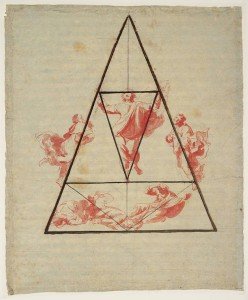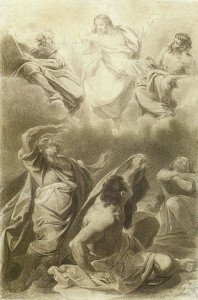
Lecture Diagram 10: Proportion and Design of Part of Raphael’s ‘Transfiguration’. Part of the Turner Bequest to the Tate (1856).
The season of Epiphany ends on the Mount of Transfiguration.
“Six days after Peter had acknowledged Jesus as the Christ, the Son of the Living God, Jesus took with him Peter and James and his brother John and led them up a high mountain, by themselves. And he was transfigured before them, and his face shone like the sun, and his clothes became dazzling white. Suddenly there appeared to them Moses and Elijah, talking with him.” (Matthew 17:1-3)
What happens upon this mountain is a true epiphany; Peter is staggered by the radiance of Jesus and by the sudden appearance of Moses and Elijah. The mountaintop seems to be God’s preferred location for such an epiphany. On multiple occasions God spoke to Moses up on a mountain, as it is recounted in the Old Testament reading this week. Elijah also had mountaintop experiences, so it should have come as no surprise that these two are there alongside Jesus as he was transfigured. Peter should have seen it coming as he had already, “acknowledged Jesus as the Christ”(Matt. 17:1), but an epiphany like this cannot be anticipated.
Peter blathers at the sight of the transfigured Christ:
“Lord, it is good for us to be here; if you wish, I will make three dwellings here, one for you, one for Moses, and one for Elijah.” While he was still speaking, suddenly a bright cloud overshadowed them, and from the cloud a voice said, “This is my Son, the Beloved; with him I am well pleased; listen to him!” When the disciples heard this, they fell to the ground and were overcome by fear. But Jesus came and touched them, saying, “Get up and do not be afraid.” (Matt. 17:4-7)
Peter’s epiphany upon the Mount of Transfiguration aligns with the death and resurrection of Jesus Christ. The disciples fell to the ground in fear and are raised by Jesus. Epiphanies destroy our previous understanding of things and give us new vision; at first we are blinded by the light, then we come to see by the very light that was once blinding. Matthew continues, “[a]s they were coming down the mountain, Jesus ordered them, ‘Tell no one about the vision until after the Son of Man has been raised from the dead.'”(Matt. 17:9) The epiphany of the transfiguration must be kept a secret until the revelation of Christ is manifested in his glorious risen body.
You would expect that this would be an important thing to share, but Jesus repeatedly tells his disciples to keep silent about the miracles he has performed:
- After healing a man of leprosy (Luke 5:14).
- After giving a deaf dumb man his hearing and speech, Mark 7:35.
- After the raising Jairus’ daughter back to life, Luke 8:56.
- Even after Peter claims Jesus is the Christ, Jesus says, “tell no one!” (Matt. 16:20, Mark 8:30, Luke 9:21)
Why keep these wondrous things secret?
Why would Jesus not want his disciples to share that he is the Christ, the Messiah?
Jesus may have silenced his disciples because epiphanies and miracles cannot be properly shared or understood apart from his resurrection. ‘Tell no one about the vision until after the Son of Man has been raised from the dead.'”(Matt. 17:9) The disciples wait for the fulfillment of the vision. Peter writes about how had seen the risen Christ and shares the tale of the transfiguration he witnessed. He holds to the light of the original epiphany he received upon the mountain, saying, “[y]ou will do well to be attentive to this as to a lamp shining in a dark place, until the day dawns and the morning star rises in your hearts.”(2 Peter 1:19) Epiphanies come to us in the darkness and illumine our minds and hearts.
The image of the rising sun lends itself well to the resurrection. The glorious radiance of the rising sun cannot be perceived directly, but it illuminates everything else. The strange mystery of Jesus Christ’s resurrection is the ultimate epiphany, not because it makes immediate sense to us, but because it makes sense of everything else. After the Son of Man had been raised from the dead we can understand why Peter called him Christ; we can understand that his miracles are glimpses of the life that he invites us to participate in. In the light of the resurrection we can see, hear, and proclaim that Jesus is the Christ. But we can only do so after the epiphany knocks us down to the ground and Jesus bids us to get up.


By The Rev. Jesse Dymond February 24, 2014 - 10:20 am
Great connections, Landon: without the resurrection, Jesus’ signs and wonders look like nothing more than magic tricks. For that matter, without seeing life through the lens of the resurrection, much of what we do and celebrate looks different: prayer, working for social justice, Christmas…
As I move into this week’s readings, I’m left with the question, “how would we live our lives, if we approached everything with the knowledge that death does not have the last word?”
By Dell Bornowsky February 26, 2014 - 12:32 pm
Thanks for getting us started Landon, I wasn’t sure I was grasping your point about seeing the assorted epiphanies in light of the resurrection until I reread Jesus exhortation to keep it hush- hush UNTIL the resurrection . Now I wonder if the transfiguration etc served as hindsight evidence FOR the resurrection. In other words the resurrection being almost too astounding to be accepted is made more plausible by remembering that something special was already going on. Perhaps Jesus exhortation to keep it quite was saying don’t make the epiphanies ends in themselves but rather points in a trajectory toward the greater epiphany (resurrection) that is to come?